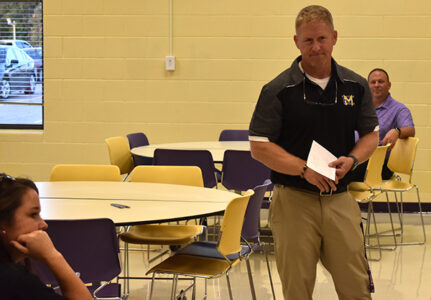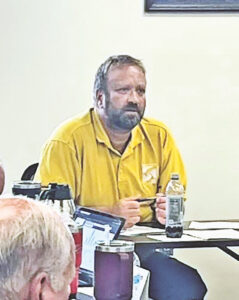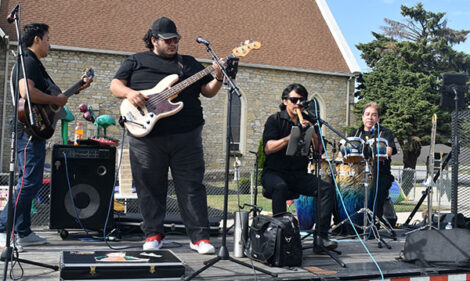New East Marshall superintendent makes case for larger bond issue during facilities committee meeting
LE GRAND — A year after a previous $13.5 million bond referendum failed with just 53 percent support at the polls, the East Marshall facilities committee — under the leadership of new Superintendent Kevin Seney — met on Wednesday night in the high school commons area to discuss plans for a larger, $19.8 million bond that, while still closing the current 6-8 Gilman building for classroom use, would repurpose it and ensure it remains under the ownership of the school district.
Seney gave a presentation with a host of slides and discussed ways to get the word out to the public in hopes of reaching the 60 percent supermajority needed to pass a bond in Iowa during the meeting, which ran just shy of an hour and a half. The bond that will be presented to voters this time around utilizes the district’s maximum bonding capacity, a $4.05 increase in the levy per $1,000 of valuation.
His overall message was simple: East Marshall’s current facilities are not meeting the needs of students and staff, and now is the time to change that. One of the first aspects he highlighted was the aging HVAC systems and the need to improve them — even if previous generations went to school without air conditioning, he said, it’s not the way people live now, and students and staff deserve better. Additionally, some of the systems are so old that replacement parts are no longer available.
“Those maintenance costs are costs that we’re spending out of our general fund or PPEL dollars or SAVE dollars that we could be saving every year and investing back into students and programs,” Seney said.
He also described the “operational inefficiencies” of continuing to utilize three attendance centers — an elementary school in Laurel, a middle school in Gilman and a high school in Le Grand — and the challenges for staff members who have to split their time between them. A community survey conducted by The Donovan Group in 2024, Seney said, revealed many of the concerns he raised during the presentation as well as security issues in light of recent instances of school violence, and 77 percent of people surveyed said they would be open to closing an attendance center along with a willingness to pay about $181 more in taxes annually to finance facilities upgrades.
The results, Seney said, indicated a need for improvements, and he then asked if any of the 25 or so people in attendance if any of them felt the current facilities were adequate. No hands went up.
“That’s good. If somebody had said yes, I wasn’t sure what I was gonna do,” he said.
One comment that troubled Seney was the idea that because of the district’s declining enrollment, which has dipped from over 900 students served in 2012 to about 590 today (a 35 percent drop), some didn’t feel the need to invest in facilities and should simply wait until East Marshall is no longer viable on its own to look for consolidation opportunities.
Enrollment, of course, is directly tied to state funding — about $8,000 per student — which in turn affects the ability to hire and retain teachers, offer unique programs and maintain aging facilities.
The available options, according to Seney, present the choices of either “doing nothing” and continuing to manage the decline with short-term “Band-Aids” for about $7 million or investing in facilities now with the hopes of attracting more families to East Marshall in the future. The larger $19.8 million bond, he contended, would serve the district well for 40 to 50 years.
“If there’s a sense of urgency that could be created, I hope that it’s around that our facilities are in such dire condition that we have to do something, and we have to do something big. And now is probably the time to do it,” he said.
Inflation and construction costs will only continue to rise in the years to come, and every month that the district doesn’t do anything adds another $115,000 in the long term. With older buildings and neighboring districts like Marshalltown and GMG passing bond issues last fall, Seney said East Marshall is falling behind the competition despite the hardworking and committed staff who continue to dedicate themselves every day.
From there, he dove into specific plans: seventh and eighth graders would be moved to a new wing on the east side of the Le Grand campus alongside HVAC improvements to the whole building and the old gym for a total cost of about $5.66 million — with soft costs, legal fees, and site work, the total figure is around $7.5 million. In Laurel, a new gym would be constructed as well as classrooms to accommodate sixth graders and HVAC improvements at an estimated cost of $6.2 million, and with the additional costs, the figure would total $8.3 million.
The Gilman option is a change from last year’s bond issue, which did not specify what would happen to the middle school after it closed, and Seney said it was based on community feedback desiring a specific plan to avoid it being boarded up and turning into an eyesore.
It would include the demolition of the 1925 and 1980 additions, remodeling the locker rooms, office space and windows in the gym and moving the administration office there — currently, the administration building is housed out of a separate space in Gilman. This proposal would cost about $2.39 million and utilize $555,000 in bonds against Securing an Advanced Vision for Education (SAVE) dollars.
Seney admitted it may not be “sexy,” but it allowed for flexibility and options like a wrestling room, a multi-purpose room or some sort of flex room — possibly even a fitness center open to the public. He presented a total of three options with various cost estimates, and it was also mentioned that a Career and Technical Education (CTE) wing could be constructed in Le Grand.
The superintendent shared a breakdown of the costs and then spent a good chunk of the meeting explaining the tax impacts for property owners in the district — with a current levy rate of $9.84 per $1,000 of valuation, East Marshall’s is the lowest in the area, well below the average of $15.76. For a $100,000 house, the annual tax increase with the $4.05 bond would be $172, and for a $175,000 house, the figure would be $317.
Trying the $2.70 bond again, Seney said, would only get the district about $12.8 million, which he didn’t feel would be sufficient for the facilities needs and would do nothing for Gilman other than demolishing the building completely. He also explained the rollback for residential properties and other credits and exemptions to highlight the fact that residents would not pay taxes on the full assessed value of their property before diving into the formula for agricultural land as well.
In addition to General Obligation (GO) bonds, Seney said the district could utilize other funding sources such as SAVE and the Physical Plant and Equipment Levy (PPEL) to offset the property tax burden for residents as GO bonds could not be used for demolition costs. About halfway through the meeting, Seney spoke of community feedback received during the previous gathering on July 15.
They didn’t feel the details of the previous bond was properly communicated to the public through various media and social media channels;
Uncertainty around the future of the Gilman building and the lack of a plan regarding it;
Long-term sustainability of the district due to declining enrollment.
If the district would dissolve in the future, he said, residents would be subject to higher tax rates in neighboring districts such as Grinnell, South Tama, GMG and Marshalltown depending on which one they were absorbed into, which prompted one attendee to remark that he didn’t want to be absorbed into STC.
After reiterating the urgency of the situation and the desire to update the district’s facilities as a means to attract families to Laurel, Le Grand, Gilman and Ferguson, Seney opened up the floor to various comments and questions from the audience, including about one for a potential FEMA grant to help pay for the gym in Laurel, which would also require a storm shelter. Tyler Riley of FEH Architects said he had not heard any recent updates on that front.
Other attendees encouraged Seney to speak before various local groups, church congregations and even city councils, and Paige Scott felt that the dire condition of the current Gilman building needed to be driven home to voters through tours and videos.
“In my opinion, Gilman needs to go,” she said. “If this doesn’t go through, we’re ultimately potentially looking at portables for students because we have nowhere to put them, because they cannot stay in that school that has mold and has a building falling down around them.”
In her view, the message needed to be more direct as opposed to “coddling” voters and telling them what might happen.
“People aren’t understanding that. I don’t know how to change that or how to say that. I don’t know how we get that across,” Scott said.
Pete Drury added that voting down the bond would not save the Gilman building as it would still have to close regardless given the current enrollment and financial outlook, citing the historical example of the Ferguson building closing in the past and the subsequent scramble to move out.
School board member Elizabeth Crandon noted that two grades had already been shifted out of Gilman three years ago due to enrollment and efficiencies with teaching staff, and she warned that the same shifts would likely continue if enrollment numbers continue to drop.
“We have operated inefficiently as a district for a number of years, and we have staff that we are trying to share between buildings to be more efficient, and honestly, it’s not fair to those staff members. I mean, it takes some of those staff members out of the classroom or out of teaching time two or three hours of the day because of travel time,” Crandon said. “And that affects the kids, so basically, we’re paying people to be in cars because we operate inefficiently from a building perspective.”
Another attendee worried about the timeframe and the lack of a sense of urgency to get the information out, which prompted Seney to ask for the committee’s help in spreading the word. Crandon lamented that in the past, the committee and the school board have held public meetings with sparse attendance, and many people simply don’t make the effort to inform themselves.
“Guys, we have been trying, trying, trying, and I don’t know what else to do. How do we get people engaged? We cannot get people engaged,” she said.
Another attendee suggested mailing out a school newsletter to make sure the information is disseminated to every resident within the district boundaries.
“I think communication is the biggest thing,” a woman in the audience said.
As the meeting concluded, committee members began the work of collecting the necessary signatures to ensure that the referendum is placed on the Nov. 4 ballot. Because the bond is above $2.70 per $1,000 of valuation, voters will have to check yes or no on two separate boxes of their ballots, and it requires a 60 percent supermajority to pass.
- T-R PHOTOS BY ROBERT MAHARRY — East Marshall Superintendent Kevin Seney, middle, engages with the audience during a facilities committee meeting in the high school commons area on Wednesday night as Alex Ferneau, left, and Tyler Riley of FEH Architects, right, look on. The committee and district leadership are preparing to present a $19.8 million bond referendum to voters this November.
- Pete Drury holds a signature petition at the conclusion of the East Marshall facilities committee meeting in Le Grand on Wednesday night. The $19.8 million bond will need approval from a 60 percent supermajority of voters to pass.








